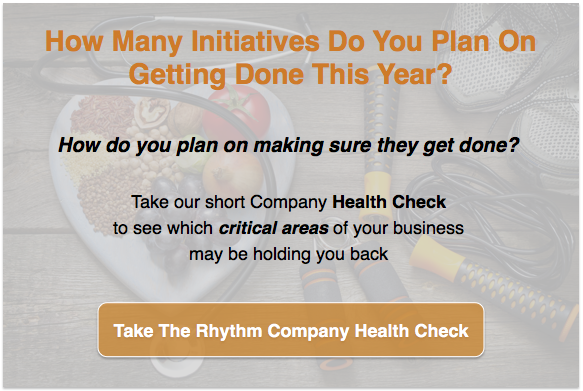You go to your doctor every year for a physical, but you rarely do this for your business. As you prepare your team for Annual Planning, it’s a great time for your annual check-up!
Do you feel like there might be some underlying issues as to why your team consistently falls short on execution? Or, that holes in your strategy might be contributing to things just feeling “off” at your company?
We work with hundreds of companies to help them find and address gaps in their strategy and execution using the Think-Plan-Do methodology.
Here are some patterns we’ve seen over the years from companies who have a bad case of the blahs - their growth has stalled, they can’t seem to get things over the finish line, they are losing good people, etc.
Are you experiencing any of these symptoms?
Short Term Memory Loss - What was our plan again?
Many times, we see companies do their planning but don’t consistently execute on their plan. It sits on a shelf or on a spreadsheet and just gets pulled out at their next quarterly (or worse - annual) planning session. Of course, progress doesn’t happen and the team loses an entire quarter (or year!) of execution time.
In your weekly team meetings, you should be talking about the priorities and KPIs that you all agreed upon during your annual and quarterly planning sessions. Those goals should be statused and stuck items should be discussed and adjustments made weekly to keep your plan on track. There will inevitably be other things that come up, but you have to stay connected to the execution of your quarterly priorities.
If you aren’t talking about progress against your Quarterly Plan every week, you might have a focus problem.
Severe Headaches - Who’s on first?
Execution issues can take many forms. Some companies are very siloed in their planning - each department makes their own plan and operates in their own little world. There is no collaboration, departments are competing for the same resources (IT, HR, etc.) and many priorities are dependent on one another across teams or are conflicting with each other altogether. The headaches only get bigger when execution begins. No one is communicating cross-functionally, departments don’t understand what each team is working on, and there is no cohesive company plan that everyone supports.
Systematic cascade planning and a solid weekly meeting rhythm solves most of these issues. For planning, the executive team should plan first, then departments should plan in a way that supports the company plan. The final step is for departments to share plans across teams to work out shared resources, dependencies and conflicts. Teams should then collaborate and follow each other’s priorities weekly with a goal of making adjustments to keep all priorities on track.
If you can’t see aligned departmental plans and a collaborative approach happening during weekly meetings, you might have an alignment and communication issue.
Temporary Blindness - Wait, we’re NOT going to hit our number?
This one can be a killer. Picture this - you’re constantly hearing from your sales team that meetings are going well, they’re confident, and everything is great. Until, Week 11 of Q3. All of a sudden, you realize the pipeline is weak, your definition of your “best” customer isn’t the same as your head of sales, and 3 of your 7 salespeople haven’t hit their numbers all year. What? Now you’re going to miss the annual revenue target and you’ll have to explain it all to your board and investors.
Two things could have helped in this scenario: working to define your Core Customer as a team and having visible dashboards with leading indicators.
When you take the time to define the characteristics of your Core Customer as a team, you pinpoint exactly the types of prospects you want to land as clients (most profitable, easy to service, etc.). Not only does it get your sales team pointed in the right direction, but it also helps your delivery team improve service and your product team develop better products.
Having visible dashboards of Key Performance Indicators (KPIs) to track your metrics is key to accountability, transparency and driving results. In this case, if each salesperson had a KPI measuring their pipeline and their revenue that they had to status weekly, you wouldn’t have been blindsided. Not only would you see it, but you would see it early enough to make adjustments and, hopefully, get things back on track.
These are only a few of the patterns we’ve seen of companies with hidden diseases. If you’d like to do a self-assessment to help find some potential maladies lurking in your company, please take our Company Health Check!
Photo Credit: iStock by Getty Images
If you enjoyed this post, here are some others you may like:
How CEOs Grow Accountable Leaders & Teams [Video]
A Leader's Template: 6 Questions to Ask in Your Next One-on-One Meeting
5 Insights You'll Learn from Executive Coaching
Employee KPI Examples: How to Measure What You Want to Move
The Five C's of Team Accountability
Strategic vs. Tactical Leaders: Which Are You? [Video]
11 Books Every CEO Should Read
Photo Credit: iStock by Getty Images



 LinkedIn
LinkedIn
 Facebook
Facebook

